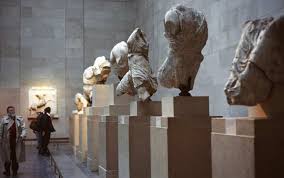Elgin marbles return to Greece more likely under Labour as ‘mood music shifts’

Cahal Milmo
Athens: Ever since the 7th Earl of Elgin was forced by debts to sell the Parthenon Sculptures to the British Museum in 1816, the exquisite vestiges of Ancient Greece have oscillated between the status of treasures and bargaining chips.
Newly-independent Greece staked its first claim for the 32 carvings and sculptures and 75m of frieze in 1830 after the art works had been removed from the ruins of the Parthenon by the Scottish aristocrat under disputed circumstances.
For his part, the cash-strapped Earl resisted a host of higher offers to pay for his divorce, including one from Napoleon, to sell to the British Museum for £35,000. The sum was less than half the ruinous amount it had cost him to recover the scuptures to Britain.
The intervening two centuries have seen the Elgin Marbles – now more commonly referred to in London and Athens as the Parthenon Sculptures – serve as totems of British imperial sprawl, only to then become icons of the global debate over whether such priceless artefacts should be return from whence they came.
Now it seems the marbles, created for the Acropolis under the tutelage of Athenian master sculptor Phidias, are once more serving as collateral in a series of multi-faceted manoeuvrings.
A Labour government wishing to mend Britain’s European fences is signalling it is open to the art works being loaned back to Greece, while the British Museum is setting out its own stall as a “lending library for the world” in a move which could lead to other disputed items leaving its eight million item-strong collection, albeit on a returnable basis.
Experts and sector insiders this week told i that they believe the “mood music” around both the Parthenon Sculptures and some antiquities held in the British Museum’s “contested collections” has shifted in recent weeks after Downing Street quietly reversed the previous government’s prickly stance on the marbles and Nicholas Cullinan, the newly-installed director at the 271-year-old museum, signalled he wanted the institution to take a “generous” stance on sharing its cultural riches.
A diplomatic reset had been on the cards following Rishi Sunak’s abrupt cancellation last November of a meeting with the Greek prime minister Kyriakos Mitsotakis after the Conservative leader took umbrage at the issue of the sculptures being raised. And Culture Minister Sir Chris Bryant was seen as making that move last week when he told Parliament that a loan of the marbles was a “matter for the trustees” of the museum.
The Government yesterday reiterated its insistence that permanent returns are not being countenanced, while also leaving the door open for the British Museum to make loans. It is understood that ministers have not as yet been asked to consider such an arrangement concerning the Parthenon Sculptures.
A Government spokesperson said: “We have no plans to change the law that would permit a permanent move of the Parthenon Sculptures. Further decisions relating to the care and management of the museum’s collections, including loaning objects, are a matter for the Trustees of the British Museum.”
George Osborne, the former Chancellor and now chairman of the British Museum, has been quietly negotiating the broad parameters of a deal over the marbles with the Greek authorities, with the aim of returning at least some to the purpose-built Acropolis Museum overlooking the Parthenon. Mr Osborne, who perhaps necessarily gives away very little about the state of these discussions, said last year that there is “a deal to be done” over the antiquities.
Opinion polling has consistently suggested that anywhere between a half and two-thirds of Britons are in favour of returning the marbles to Greece – a position which past Labour governments have also flirted with.
Labour sources this week went out of their way to emphasise that the legal position over the Parthenon Sculptures, and indeed all other restitution claims aimed at the British Museum, remains unchanged. Under a law passed in 1963, which the new Government has said it is not going to repeal, the museum is formally banned from permanently returning any items, with only a handful of narrow exceptions.
But it remains the case that a key plank of the foreign policy being pursued by Sir Keir, who held talks with Mr Mitsotakis last November during which the issue of the marbles was raised, is a rapprochement with European countries after the bruises of Brexit.
As such, the 2,500-year-old sculptures represent a potent weapon in Britain’s soft-power armoury.
In the diplomatic netherworld of restitution, where personal relations can be the difference between failure and success, one foreign policy old-hand pointed out this week that the British prime minister had been placed next to his Greek counterpart during the four-hour Paris Olympics opening ceremony.
One senior figure in the museum world said: “Ultimately, it will be up to the British Museum to decide what happens with the marbles – they belong to the museum, not the government. But we can’t pretend that these things happen in a political vacuum and you require a certain mood music – an entente – for things to happen.”
Alexander Herman, director of the UK-based Institute of Art and Law and author of an authoritative book on the sculptures, The Parthenon Marbles Dispute, told i: “There has been a subtle shift in tone with the new UK government and definite support for the new approach of the British Museum, which is focused on building constructive partnerships with countries and communities of origin.
“The previous government had taken a hostile stance on the museum’s envisaged partnerships based around long-term loans. They are now aligned once more it seems.”
It is an alignment which coincides with what some observers see as a significant change in the outlook of the British Museum itself. The institution, the world’s first public national museum, has been battered by controversies of late, not least the alleged loss or theft of some 2,000 items from its collection which resulted in antiquities supposedly safeguarded for the public good into perpetuity being offered for sale on eBay.
Mr Cullinan, who oversaw a lauded overhaul of the National Portrait Gallery in London before taking up perhaps the most prestigious and tricky post in the British museum world this summer, set out his stall earlier this month by suggesting the UK’s premier institution would be more open to lending key items around the world.
Asked earlier this month on BBC Radio 4’s Today programme what he thought of the suggestion by historian Mary Beard, who is also a trustee of the museum, that it should position itself as a “lending library for the world”, Mr Cullinan said: “I think that’s a really compelling idea. That’s something that I’ve been thinking about too… How you take a great historic institution and make it live in the present, and how we can turn some of the more difficult aspects around the discussion around the museum into a positive. For example, how we can be generous and to partnership nationally, internationally, all of those issues.”
In common with many major world museums, the British Museum’s collection is freighted with the acquisitive wrongdoings of the colonial era. Its website offers six headings for what is describes as “contested objects”, among them the Benin Bronzes – a collection of 500-year-old sculptures looted from modern-day Nigeria by a punitive British military expedition in 1897, and the Maqdala collection, an array of 80 objects, many of them sacred, pillaged from Ethiopia in 1868.
In a potentially significant revelation, Mr Cullinan said he had commissioned his own inventory of the museum’s holdings which had identified “around 15” items or collections of items described as being “subject to discuss or contest”.
Despite the director’s emphasis on being open about such collections, when the museum was this week asked by i to specify which items Mr Cullinan was referring to it declined to do so. Noting the restrictions imposed by the 1963 law, Mr Cullinan told the BBC: “What we can do is we can collaborate and share and I think that is something that I’m very focused on.”
Mr Herman said such statements suggested the British Museum, which is also at the beginning of a vast and expensive project to overhaul its building and displays, is moving with the times. He said: “The British Museum’s position has certainly shifted over the last two years, as it abandoned its formerly defensive and passive-aggressive approach to restitution. This is a positive development that reflects the ethical principles at the core of museum practice today: building relations with communities and countries of origin, being willing to share collections with museums in countries of origin and being open to initiate dialogue around restitution.”
An example of this new approach was unveiled in May when an agreement by the British Museum and the V&A with Ghana led to the return on a three-year loan of 32 items of gold and silver regalia looted or coerced from the ancient Asante kingdom.
But amid such signs of a partial thawing in the restitution debate, the question remains of just whether its biggest issue of all – the Parthenon Sculptures – can be resolved.
Doing so would firstly be likely to require a pragmatic coalition between a Tory big beast, in the shape of Mr Osborne, and a Labour government, although figures in the museum world approached this week saw little reason why such an arrangement would not function.
The more intractable issue is whether a compromise can finally be ground out between the longstanding Greek position that the Parthenon Sculptures in London, which represent roughly half of all extant Acropolis treasures, are effectively stolen goods (in the words of Lord Byron, “sacred objects plundered by profane English hands”), and the UK’s contention that the marbles were legally obtained and the British Museum’s collection is irreducible.
Behind the scenes, Mr Osborne and his Greek interlocutors – pursuing what the British Museum calls a “Parthenon Partnership” – are thought to have been exploring whether an incremental arrangement of returning a growing proportion of the marbles to Athens as a rotating “deposit” can be reconciled with a refusal by Greece to countenance any “loan”.
In a statement, the British Museum said discussions with Athens were “ongoing and constructive”.
A spokesperson said: “We believe that this kind of long-term partnership would strike the right balance between sharing our greatest objects with audiences around the world, and maintaining the integrity of the incredible collection we hold at the museum.”
But there are few who believe this 200-year-old game of brinkmanship is likely to end imminently, nor without considerable give and take on both sides.
Mr Herman pointed out that Mr Osborne himself has acknowledged that a deal can only be done if Britain and Greece abandon their “red lines”. But the expert added: “The ball is squarely in the Greek court: it will be for them to decide whether they take the opportunity to engage and put aside, at least for the time being, their traditional refusal to countenance a loan. In order to reach a sensible resolution, each side will inevitably need to compromise.”





